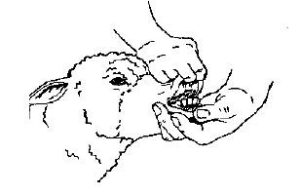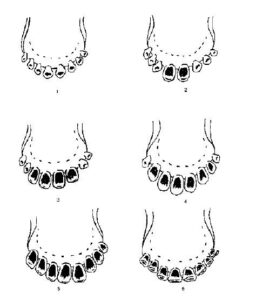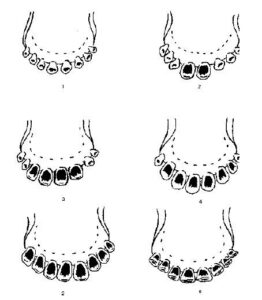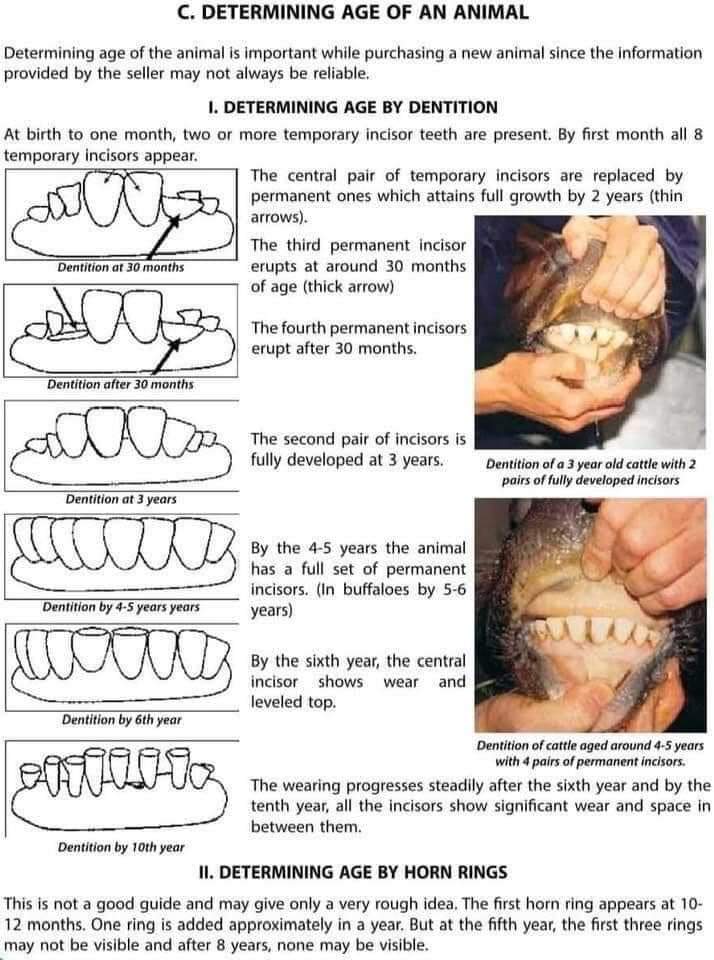Age estimation of livestock
Determination of Age of Farm animals
The approximate age of cattle may be determined by examining the teeth as illustrated in Diagram .The tooth method of aging cattle involves noting the time of appearance and the degree of wear on the temporary and permanent teeth. The temporary or milk teeth, are easily distinguished from the permanent teeth by their smaller size and whiter color. At maturity cattle have 32 teeth, 8 of which are incisors in the lower jaw. The two central incisors are known as pinchers; the third pair are called second intermediates or laterals; and the outer pair are known as the corners. There are no upper incisor teeth; only the thick, hard dental pad. The tooth method of aging cattle is more accurate when animals are grazed for their entire life on “soft feed” (irrigated pasture). Under rough feed conditions, such as desert rangelands, teeth are worn at a much faster rate. Under rough feed conditions, accuracy of aging cattle is reduced, particularly in animals over five years of age where tooth wear is the only indicator. Adjusting the accompanying chart to match feed conditions is essential to accurately determine the age of cattle. The best way to adjust the accompanying age chart to an individual ranch is to examine teeth of individuals with known ages and adjust the scale depending on wear. Becoming proficient at aging cattle by the tooth method requires practical experience and a lot of practice. It also requires theoretical knowledge of the information presented in Diagram .
The age of an animal can be known accurately if the date of birth is available or can be estimated by looking into the arrangement, structure and conformation of teeth (dentition). Determination of age of an animal is important for the following reasons: • To issue health certificate; • To select and purchase animals; • To know the breeding status of. the animal; • To estimate the value of the animal; and • To determine, the dose of the drugs as per age.
Objective-
After performing this experiment, you should be able to: • determine age of the given animal based on the arrangement, structure and conformation of teeth.
The approximate age of an animal can be determined by looking into the time of appearance and the degree of wear and tear of teeth. Every animal ,has two sets of teeth, one set present immediately after birth (called temporary or milk teeth) and the other set is formed after the first set falls off (called the permanent teeth). The different teeth present in cattle, buffaloes, sheep and goats are the Incisors (seen at the front side, only on the lower jaw), Canine, Premolars and Molars (the grinding teeth). There are four.types of incisors, like the Centrals (middleone), Centro-lateral (next to the middle on either side), Lateral (next to the centro-lateral on either side) and the Corners (last or the corner pair). Dental formula is the arrangement of different types of teeths present on one side of the jaw of an animal. In simple terms, it indicates the total number of teeth present in any set of dentition of a particular species expressed in a single form of figures. Determination of Age of an Animal It consists of a horizontal line above, which indicates the number of teeths present in the left or right half of the upper jaw in each category; while below the line, the corresponding numbers of teeth present in the lower jaw are mentioned. The first figure represents incisors, second canines, third premolars and the fourth molars present in the left or right half of the jaw. Hence, the total number of teeth present can be obtained by multiplying the entire formula by two.
The age of animals can be determined by examination of the front teeth. However, you will not able to determine the exact age, especially in older animals.
How to hold the animals to check their teeth:

How to hold sheep and goat to check their teeth

How to hold cattle and buffalo to check their teeth
Temporary (Milk) and Permanent teeth
- Young animals, like children, have temporary or milk teeth which will be replaced by permanent teeth.
- Young ruminants have 20 temporary teeth, adult ruminants have 32 permanent teeth.
Temporary (milk) teeth:
| Upper jaw | No front teeth | 6 back teeth |
| Lower jaw | 8 front teeth | 6 back teeth |
Permanent teeth:
| Upper jaw | No front teeth | 12 back teeth |
| Lower jaw | 8 front teeth | 12 back teeth |
Remember that you will not be able to determine the exact age of the animal from its teeth, but there will be a few months either way.
You should develop the habit of regularly checking the teeth (not just for age) because bad or worn teeth will stop an animal eating or chewing the cud. Such an animal is of no use.
Age of goats and sheep
- Animal under one year old (no permanent teeth)
- One year old (2 permanent teeth)
- Two years old (4 permanent teeth)
- Three years old (6 permanent teeth)
- Four years old (8 permanent teeth)
- Old animal, more than four years old

Age of goats and sheep
Age of cattle
- Under two years old (No permanent teeth)
- Two years three months (2 permanent teeth)
- Three years old (4 permanent teeth)
- Three years six months (6 permanent teeth)
- Four years (8 permanent teeth)
- Old animal, over four years old

Age of cattle
Age of Buffalo
- Under three years old (no permanent teeth)
- Two years six months (2 permanent teeth)
- Three years six months (4 permanent teeth)
- Four years six months (6 permanent teeth)
- Five to six years (8 permanent teeth)
- Old animal

Age of buffalo
DR OP SAHA,KALYANI
IMAGE-COURTESY-GOOGLE


